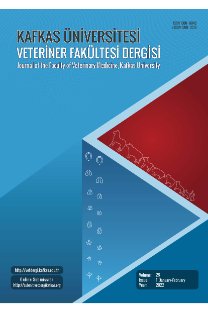The effect of orally administrated β-glucan and dietary restriction on faecal microfora in rats
Oral yolla uygulanan β-glukan ve diyet kısıtlamasının ratların fekal mikroforasına etkisi
___
- 1. Gibson GR, Probert HM, Van Loo JAE, Roberfroid MB: Dietary modulation of the human colonic microbiota: updating the concept of prebiotics. Nutr Res Reviews, 17, 257-259, 2004.
- 2. Saad N, Delattre C, Urdaci M, Schmitter JM, Bressollier P: An overview of last advances in probiotic and prebiotic field. LWT Food Sci Technol, 50, 1-16, 2013.
- 3. Özpınar H, Aydın İH, Klasing KC, Tekiner İH: Interaction of manan oligosaccharide with immune system transport of MOS in to the Lamina Propria. Kafkas Univ Vet Fak Derg , 18, 121-128, 2012.
- 4. Yalçın S, Yalçın S, Eser H, Şahin A, Yalçın SS, Güçer Ş: Effects of dietary yeast cell wall supplementation on performance, on carcass characteristics, antibody production and histopathological changes in broilers. Kafkas Univ Vet Fak Derg, 20, 757-764, 2014. DOI: 10.9775/ kvfd.2014.11088
- 5. Gülmez M, Güven A: Probiyotik, prebiyotik ve sinbiyotikler. Kafkas Univ Vet Fak Derg, 8, 83-89, 2002.
- 6 . Lam KL, Cheung PCK: Non-digestible long chain beta-glucans as novel prebiotics. Bioact Carbonhydr Dietary Fibre , 2, 45-64, 2013.
- 7. Russo p, Lopez P, Capozzi V, de Palencia PF, Duenas MT, Spano G, Fiocco D: Beta-glucans improve growth, viability and colonization of probiotic microrganisms. Int J Mol Sci, 13, 6026-6039, 2012.
- 8. Licht TR, Ebersbach T, Frøkiær H: Prebiotics for prevention of gut infections. Trends Food Sci Technol, 23, 70-82, 2012.
- 9. Sarmiento-Rubiano LA, Zuniga M, Perez-Martınez G, Yebra MJ: Dietary supplementation with sorbitol results in selective enrichment of lactobacilli in rat intestine. Res Microbiol, 158, 694-701, 2007.
- 10. Turunen K, Tsouvelakidou E, Nomikos TZ, Mountzouris KC, Karamanolis D, Triantafillidis J, Kyriacou A: Impact of beta-glucan on the fecal microbiota of polypectomised patients: A pilot study. Anaerobe , 17, 403-406, 2011.
- 11. Williams BA, Mikkelsen D, Le Paih L, Gidley MJ: In vitro fermentation kinetics and end-products of cereal arabinoxylans and (1,3;1,4)-b-glucans by porcine faeces. J Cereal Sci, 53, 53-58, 2011.
- 12. Reilly P, Sweeney T, OShea C, Pierce KM, Figat S, Smith AG, Gahan DA, ODoherty JV: The efect of cereal-derived beta-glucans and exogenous enzyme supplementation on intestinal microfora, nutrient digestibility, mineral metabolism and volatile fatty acid concentrations in finisher pigs. Animal Feed Sci Tech , 158, 165-176, 2010.
- 13. Kuda T, Enomoto T, Yano T: Efects of two storage β-1,3-glucans, laminaran from Eicenia bicyclis and paramylon from Euglena gracili, on cecal environment and plasma lipid levels in rats. J Funct Foods, 1, 399- 404, 2009.
- 14. Snart J, Bibiloni R, Grayson T, Lay C, Zhang H, Allison GE, Laverdiere JK, Temelli F, Vasanthan T, Bell R, Tannock GW: Supplementation of the diet with high-viscosity beta-glucan results in enrichment for Lactobacilli in the rat cecum. Appl Environ Microbiol, 72 (3): 1925-1931, 2006.
- 15. Scott KP, Gratz SW, Sheridan PO, Flint HJ, Duncan SH: The infuence of diet on the gut microbiota. Pharmacol Res, 69, 52-60, 2013.
- 16. Aydın C, Ince E, Koparan S, Cangul IT, Naziroglu M, Ak F: protective efects of long term dietary restriction on swimming exercise-induced oxidative stres in the liver, heart and kidney of rat. Cell Biochem Funct, 25, 129-137, 2007.
- 17. Aydın C, Sonat F, Sahin SK, Cangul IT, Ozkaya G: Long term dietary restriction ameliorates swimming exercise-induced oxidative stres in brain and lung of middle-aged rat. Indian J Exp Biol, 47, 24-31, 2009.
- 18. Roberts D, Greenwood M: Practical Food Microbiology. 3 th ed., 160- 161, Blackwell Publishing, Massachusetts, USA, 2003.
- 19. Rubio R, Jofre A, Martin B, Aymerich T, Garriga M: Characterization of lactic acid bacteria isolated from infant faeces as potential probiotic starter cultures for fermented sausages. Food Microbiol, 38, 303-311, 2014.
- 20. Murphy P, Dal Bello F, ODoherty JV, Arendt EK, Sweeney T, Cofey A: Effects of cereal β-glucans and enzyme inclusion on the porcine gastrointestinal tract microbiota. Anaerobe , 18, 557-565, 2012.
- 21. Lowry VK, Farnell MB, Ferro MJ, Swaggerty CL, Bahl A, Kogut MH: Purified β-glucan as an abiotic feed addictive up-regulates the innate immune response in immature chickens against Salmonella enterica serovar Enteritidis. Int J Food Microbiol, 98, 309-318, 2005.
- 22. Zhoua M, Pub C, Xiaa L, Yua X, Zhua B, Chenga R, Xua L, Zhang J: salecan diet increases short chain fatty acids and enriches beneficial microbiota in the Mouse cecum. Carbonhydr Poly, 102, 772-779, 2014.
- 23. Mitsou EK, Panopuolou N, Turunen K, Spiliotis V, Kyriacou A: Prebiotic potential of barley derived β-glucan at low intake levels: A randomised, double-blinded, placebo-controlledclinical study. Food Res Int, 43, 1086-1092, 2010.
- 24. Duan R, Chen X, Wang F, Zhang T, Ling P: Oral administration of heparin or heparosan increases the Lactobacillus population in gut microbiota of rats. Carbonhydr Polym , 94, 100-105, 2013.
- ISSN: 1300-6045
- Yayın Aralığı: 6
- Başlangıç: 1995
- Yayıncı: Kafkas Üniv. Veteriner Fak.
A. Ebru BORUM, CÜNEYT ÖZAKIN, MESUT ERTAN GÜNEŞ, LEVENT AYDIN, MİHRİBAN ÜLGEN, İBRAHİM ÇAKMAK
Seasonal, geographical, age and breed distributions of equine viral arteritis in Iran
Shahin NEJAT, Hassan MOMTAZ, Mehrdad YADEGARI, Shayan NEJAT, Farhad DEHKORDI SAFARPOUR, Faham KHAMESIPOUR
Mustafa JAMIL, Muhammad IJAZ, Muhammad ALI MUDDASSIR
Efects of cage stocking density on egg quality traits in Japanese quails
Mahmoud Salah EL-TARABANY, Tamer Mohamed ABDEL-HAMID, Hesham Hosny MOHAMMED
The presence of Listeria species in corn silage and raw milk produced in Southeast Region of Turkey
HİSAMETTİN DURMAZ, MEHMET AVCI, OSMAN AYGÜN
FERAY ALKAN, MEHMET ÖZKAN TİMURKAN, İLKE KARAYEL
KAMBER DEMİR, Gül ÖZTÜRK BAKIRER, Ümit CİRİT, H. Hakan BOZKURT, ABİT AKTAŞ, Sema BİRLER, KEMAL AK, SERHAT PABUCCUOĞLU
ARZU FUNDA BAĞCIGİL, SERKAN İKİZ, SEYYAL AK, NACİYE YAKUT ÖZGÜR
BERNA EMSEN STEİNMAN, AHMET DODOLOĞLU
Mitotane-induced hypoadrenocorticism in a dog with hyperadrenocorticism
EKREM ÇAĞATAY ÇOLAKOĞLU, ALİ EVREN HAYDARDEDEOĞLU, Hadi ALİHOSSEİNİ, ARİF KURTDEDE
